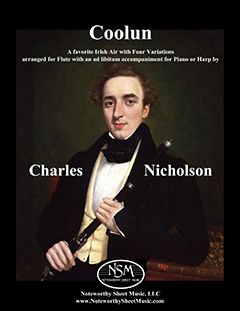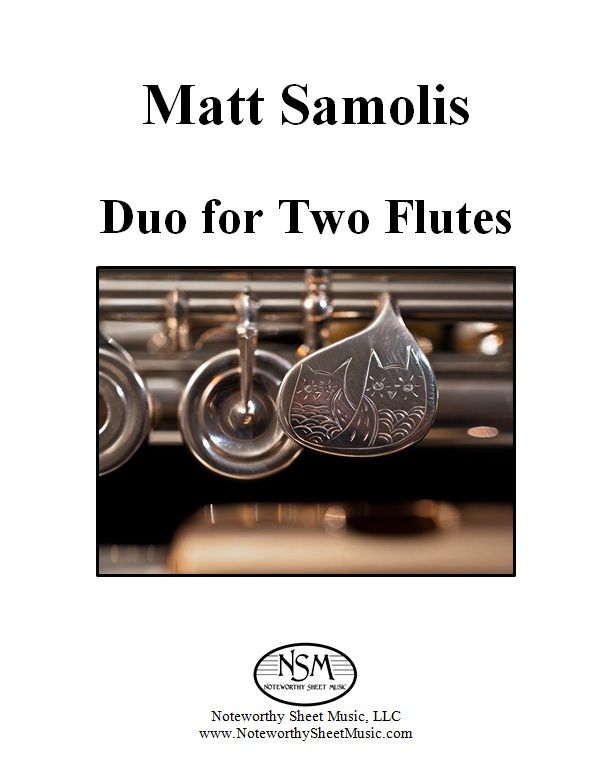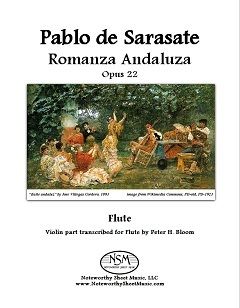flute
All scores that include a part for at least one flute.
Nicholson - Coolun - Fl or Fl & Pf or Fl & Hp
 Coolun, A favorite Irish Air with Four Variations, by C. Nicholson
Coolun, A favorite Irish Air with Four Variations, by C. Nicholson
Gassett Collection - Facsimile Edition by C.A.Vater/Noteworthy Sheet Music
Piano Score and Flute Part, PDF $9.99
Charles Nicholson (1795-1837) was a masterful, hugely popular, and highly influential English flutist and teacher, famous for his individual style and powerful tone. Among Nicholson's compositions are 13 fantasies and 15 airs with variations, including Coolun. A favorite Irish Air with Four Variations arranged for the Flute with an ad libitum Accompaniment for the Piano Forte, or Harp. The "Coulin" or "Coolan" was described in an 1833 letter to the editor of the Dublin Penny Journal (www.libraryireland.com) as "an air, that once heard even in the earliest infancy, can never be forgotten—a melody which breathes the most touching tenderness and exquisite sensibility, and the memory of which, enables the Irish to hear Scotland's 'O, Nanny wilt thou gang with me,'—or her 'Banks and Braes,' without envious repinings."
Nicholson's consummate rendition of Coolun is highly effective when played either as a solo for flute alone or by flute with accompaniment of piano, lever harp, or pedal harp. The Gassett Collection print from which our facsimile was created consists of a score for piano forte and flute, without a separate flute part. The flute part included in our edition was created from the score using a modern music notation software program.
Noteworthy Sheet Music's publication of Coolun was favorably reviewed by Katherine Borst Jones in the January, 2014 issue of Flute Talk magazine. You can read the review, reproduced on our website for your convenience, or at Flute Talk (subscribers).
For additional information about the Gassett Collection, please see see our article An Introduction to the Gassett Collection.
Piano score, 6 pages; Flute part, 5 pages; Total, 15 pages.
Preview==============================================================================
To order our print edition of Coolun, A Favorite Irish Air arranged for Flute and Piano or Harp for $16.98 plus a $5.95 shipping and handling fee to addresses in the USA. Use the Contact Us form to let us know which hard copy publication(s) you would like to purchase, along with your email contact information and USPS mailing address. We will then send you a PayPal invoice for the sale and, once we receive notice from PayPal that you have paid for the item(s), we will ship your music to the address provided.
Popp - Greetings to Hungary - Flute and Piano
 Greetings to Hungary, Op.407, by Wilhelm Popp
Greetings to Hungary, Op.407, by Wilhelm Popp
Flute and Piano
Flute Part and Piano Score, PDF $0.00
Wilhelm Albrecht Otto Popp (1828-1903) was an esteemed German composer, flutist, and pianist. He received his flute training from Caspar Kummer and Louis Drouet, and served as court pianist and flutist at the Ducal Saxon Court Theater in Coburg-Gotha. In 1867 he moved to Hamburg and became first flute of the Hamburg Philharmonic Orchestra. Popp composed some 600 works, many of which were written for flute and piano; most of his compositions were published in his lifetime and were well-known to musicians of his day.
Wilhelm Popp’s Gruß an Ungarn (Greetings to Hungary) was first published for flute and orchestra in 1890, and an edition for flute and piano was published in 1899. NSM re-notated the flute and piano version, changing only the formatting and adding bar numbers and a new cover page. With a decidedly Hungarian sentiment, this piece is great fun to play and provides an enjoyable, exciting listen for audiences as well.
Click for a free download of our re-typeset edition of Popp’s Gruß an Ungarn.
Piano score, 8 pages; Flute part, 5 pages; Total 16 pages.
Reinecke - Lieder - Voice, Violin (Fl/Afl), Piano
 Waldesgruss and Frühlingsblumen, Op.26, by C. Reinecke
Waldesgruss and Frühlingsblumen, Op.26, by C. Reinecke
Facsimile Edition plus Transcriptions for Flute & Alto Flute by C.A.Vater
Score for Violin, Voice, & Piano, Violin Part, Flute & Alto Flute Parts, PDF $9.98
Carl Reinecke (1824-1910) was a renowned German pianist, composer, conductor, and teacher of composition. He composed numerous works, and for over 35 years was a leader of the music scene in Leipzig. Reinecke's Op.26 includes two songs for voice with accompaniment of violin and piano: No.1, Waldesgruss (The Forest's Greeting); and No.2, Frühlingsblumen (Spring Flowers). The vocal range of Reinecke's Op.26 lieder extends from C4 to A5, and thus is well-suited for either soprano or mezzo-soprano.
Our edition contains an "enhanced" facsimile of the original score and violin part, plus new transcriptions of the violin part for either alto flute or flute. Thus, the two songs may be performed utilizing the accompaniment of violin, alto flute, or flute, along with the voice and piano. Alternatively, these pieces work very well as an instrumental arrangement with the voice part played on flute, accompanied by alto flute and piano.
Score, 6 pages; Violin, Alto Flute, and Flute parts, 2 pages each; Total, 18 pages.
PreviewReissiger & Fürstenau - Les Inseparables! - Fl & Pf
 Les Inseparables!, Op.45, by Reissiger & Fürstenau
Les Inseparables!, Op.45, by Reissiger & Fürstenau
Grand Original Duets for Piano and Flute, No.1
Gassett Collection - Facsimile Edition by C.A.Vater/Noteworthy Sheet Music
Flute and Piano Parts, PDF $20.25
Carl Gottlieb Reissiger's Opus 45 was written as a Sonata for Violin and Piano, but was adapted for flute by Anton Bernhard Fürstenau. Fürstenau (1792-1852) composed and arranged many works for flute. He was among the most admired flutists of the 19th century and remains a well-known favorite of flutists today. Reissiger (1798-1859) was an accomplished composer of opera, orchestral, and chamber music. An influential figure in the city of Dresden, he served as Director of the Dresden Opera and later as Kapellmeister. Les Inseparables! No.1, is the first of the Three Grand Original Duets for Piano and Flute by Reissiger and Fürstenau. The piece, which consists of three movements, is a virtuosic work that should delight and challenge both players.
For additional information about the Gassett Collection, please see see our article An Introduction to the Gassett Collection.
Piano part, 21 pages; Flute part, 6 pages; Total, 33 pages.
PreviewReissiger & Sedlatzek - La Pasta - Fl & Pf
 La Pasta! Op.36, by Reissiger & Sedlatzek
La Pasta! Op.36, by Reissiger & Sedlatzek
Concertantes Variations sur la Cavatina de Rossini, No.3
Gassett Collection - Facsimile Edition by C.A.Vater/Noteworthy Sheet Music, with a Foreword by Peter H. Bloom
Flute and Piano Parts, PDF $13.50
Reissiger and Sedlatzek's work La Pasta is a particularly effective concert piece with which the accomplished flutist can enthrall a diverse audience by evoking the dramatic majesty of grand opera while applying the scintillating techniques of the 19th century virtuoso. La Pasta is flutist Johann Sedlatzek's homage, celebration, and souvenir of the redoubtable mezzo-soprano Giuditta Pasta (1798± - 1866±), arranged by the superb composer/conductor Carl Gottlieb Reissiger. Pasta (nee Negri) was a cynosure of Italian opera who created brilliant dramatic roles for Bellini, Donizetti, and Rossini. Legendary Maria Callas (1923-77) is often compared to Pasta by opera aficionados, but few are likely to have heard both in their prime. — P. H. Bloom, 5/23/2011
For additional information about the Gassett Collection, please see see our article An Introduction to the Gassett Collection.
Piano part, 13 pages; Flute part, 5 pages; Total, 24 pages
PreviewRobichaux - Recurrence - Flute & Piano
 Recurrence, by Ben Robichaux
Recurrence, by Ben Robichaux
Contemporary Composition for Flute and Piano
Flute Part and Piano Score, PDF $12.99
NSM welcomed composer Ben Robichaux as a new contributor to our catalog in early June, 2017, when we published his piece Recurrence for flute and piano. For details of Mr. Robichaux's background, interests, and other works, please click the link to access the Composers section of the NSM website.
Recurrence was written for the composer's friend Michael Lyons. As outlined in the program notes, the "duet is framed in a traditional rondo form: ABACA. The returns of the A theme are never literal returns and repeated materials among the differing sections are never identical repetitions. These returns of A are the inspiration for the title, and the re-occurrence of the A material is a study on the lengths that a theme can be stretched and still be recognizable. The returns undergo extensive development. The B and C sections are meant to be extreme contrasts to the A sections as a means of cleansing the aural palate in order to erase the listener's memory of the theme. Despite the great lengths taken to blur the primary theme, its recognizability is undeniable. The closing section is a reflection on the basic differences among the three occurrences of the main theme. This final section is a summation of the processes that have previously been blurred by the contrasting sections of the piece. Ultimately the form portrays a futile fight that concludes with a peaceful resignation to the inevitable."
![]() The premiere of Recurrence took place in July, 2017, with Kenneth Cox (flute) and Bronwyn Schuman (piano). The performance was recorded by audio engineer Charles Hagaman; a sample can be heard by clicking the mp3 icon.
The premiere of Recurrence took place in July, 2017, with Kenneth Cox (flute) and Bronwyn Schuman (piano). The performance was recorded by audio engineer Charles Hagaman; a sample can be heard by clicking the mp3 icon.
The cover artwork for our publication was created by Scoop Brancisco, used with permission.
Piano score, 10 pages; Flute part, 3 pages; Total, 15 pages.
PreviewSaint-Saëns - Fantaisie - Flute
 Fantaisie, Op.124, by Camille Saint-Saëns
Fantaisie, Op.124, by Camille Saint-Saëns
Transcribed for Flute (originally for violin) by Peter H. Bloom
Flute Part, PDF $8.98
The following excerpt is taken from Peter H. Bloom's foreword to the edition:
"We flutists are always on the lookout for great repertoire to perform with harp, and the Fantaisie is a perfect gem to purloin from the violinists' repertoire. The expressively romantic melodies, lush impressionistic sonorities, athletic intervals, diversity of articulation, variety of dynamics, and evocative exoticism are ideal for the flute. The few problems of range are easily modified, customized, accommodated. As a duo, the work features both instruments in equally prominent and demanding roles. It's no surprise, then, that a number of flute transcriptions have been generated over the years. My goal, in this current work, is to provide fellow flutists with a significantly fresh approach to the Fantaisie.
Although a simplified adaptation of the Fantaisie is fairly straightforward, an arrangement that preserves the thrilling virtuosic intensity and rhetorical thrust of the work is another matter. An accurate presentation of Saint-Saëns's aural palette is essential to an authentic performance of the Fantaisie, and methods of achieving dynamic balance and tonal color often differ between flute and violin. The rhetorical nuances of articulation between the two instruments also require different approaches to achieve equivalent interpretations. The treatment of the violin pizzicato at measure 178, the elimination of articulation marks at measure 11, the inversions of double-stops/tremolos at measure 43-44 and 77-86, and the octave transposition from measure 184-194 exemplify these accommodations.
Violin double-stops present a conundrum. Technically impossible on the flute, double-stops are often reduced to a single line. The lower part is simply excised. But discarding the sonic complexity and virtuosic gesture of Saint-Saëns's parallel voicing dilutes the music and belies the composer's dramatic intentions. I've suggested double-stops be executed, on the flute, as tremolos. They're somewhat challenging but not impossible. Consider that the tremolo, as a virtuoso flute technique, was perhaps more popular during the composer's lifetime than in the late 20th and early 21st centuries.
Changes to the original violin part are made, here, with the intention of conserving the composer's ingenious creation. After a decade of study, experimentation, adjustment, and performance of this work, I've settled on a transcription for flute that conveys, with integrity, the musical spirit of the original orchestration."
P. H. Bloom, May 11, 2013 ©
![]() Click the icon to listen to a portion of the Saint-Saëns's Fantaisie performed by the duo "2", Peter H. Bloom on flute and Mary Jane Rupert on harp. Or watch part of a performance video on YouTube.
Click the icon to listen to a portion of the Saint-Saëns's Fantaisie performed by the duo "2", Peter H. Bloom on flute and Mary Jane Rupert on harp. Or watch part of a performance video on YouTube.
Fantaisie, Op.124 was written originally for violin and harp. We provide the Fantaisie flute part transcribed by P. H. Bloom; the harp part is available as a free PDF download from online libraries of public domain music, such as imslp.org.
Flute part, 7 pages; Total, 12 pages.
Preview
========================================================
We also offer a professionally-printed hard copy edition of Fantaisie, Op.124 by Saint-Saëns, transcribed for Flute for $14.99 plus a $5.95 shipping and handling fee to addresses in the USA. Use the Contact Us form to let us know which hard copy publication(s) you would like to purchase, along with your email contact information and USPS mailing address. We will then send you a PayPal invoice for the sale and, once we receive notice from PayPal that you have paid for the item(s), we will ship your music to the address provided.
Samolis - Canal - Soprano & Flute
 Canal, by Matt Samolis
Canal, by Matt Samolis
Contemporary Composition for Soprano and Flute, PDF $13.95
Matt Samolis began studying flute, then later composition and tenor banjo. He has worked with ensembles at New England Conservatory, Brandeis University, and Tufts University, as well as Open Hand Theatre, Pilgrim Research Collaborative, and numerous other projects. Currently, his primary focus is composition, curating, and performing as a flutist with various local groups, as well as his drone alliance, The Metal & Glass Ensemble.
Canal is written in a free, self referential style, and uses the text of Roy Campbell's poem of the same name, written in 1920. Despite the somber text, the mood is idyllic and somewhat reminiscent of the contemporary musical language in use at that time. Each player also has a brief ad lib section, where they can interpret the material as they choose.
Click to listen to two snippets of an audio recording of Canal, performed by soprano Noell Dorsey and composer/flutist Matt Samolis: ![]() Canal Owlseyes
Canal Owlseyes ![]() Canal Whiteflame
Canal Whiteflame
Score for Soprano and Flute, 5 pages; Total, 7 pages.
Preview==============================================
US customers may purchase professionally-printed hard copies of Canal from Noteworthy Sheet Music for $20.93 plus a $5.95 shipping and handling fee. Please use the Contact Us form to let us know which print edition(s) you would like to purchase, along with your contact information and your USPO mailing address.
Samolis - Duo for Two Flutes - Flutes
 Duo for Two Flutes, by Matt Samolis
Duo for Two Flutes, by Matt Samolis
Contemporary Composition for Two Flutes, PDF $17.99
Duo for Two Flutes was written using twelve tone techniques. The original tone row was divided in half, with each set of six tones being used to generate one of the flute parts. Frequently changing time signatures reflect compositional organization of the pitches, and does not establish meter. The piece has a playful, somewhat mechanical feel.  To listen to bits of a recording of Duo for Two Flutes performed by Matt Samolis and Peter H. Bloom, click on the icons below.
To listen to bits of a recording of Duo for Two Flutes performed by Matt Samolis and Peter H. Bloom, click on the icons below.
Score for Two Flutes, 8 pages; Total, 11 pages.
PreviewSarasate - Romanza Andaluza - Flute
 Romanza Andaluza, by Pablo de Sarasate
Romanza Andaluza, by Pablo de Sarasate
Transcribed for Flute (originally for violin) by Peter H. Bloom
Flute Part, PDF $6.66
'Pablo Sarasate was one of those rare violin virtuosos whose compositions, while designed to display instrumental athleticism, also expressed elegance, economy, imagination, a suave sensuality, and musical integrity. His music befits the sort of technique that, although acrobatic, is captivating rather than assaultive; evocative rather than provocative. It's with this spirit—to amuse, amaze, and engage the audience while providing a satisfying challenge to the performer—that I've adapted his Romanza Andaluza for flute.
Sarasate frequently used the musical material of folk songs and dances from his native Spain as a framework for his pieces. With the melody prescribed, the harmonies implied, and the style both familiar and exotic, he would paraphrase, embellish, and interpret as if to say "with the violin, we can do this..." Inspired by his source material, his methods, and his style, I propose that: With the flute, then, we can do this...' ― Peter H. Bloom, June 23, 2012 ©
Romanza Andaluza, Op.22 was written originally for violin and piano. Editions of the piano score (click to access) are available as free PDF downloads from online libraries of public domain music, such as imslp.org. We provide the Flute part - click below to preview p1.
Flute part, 4 pages; Total, 6 pages.
Preview